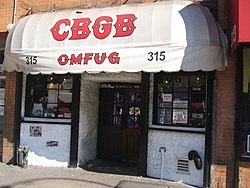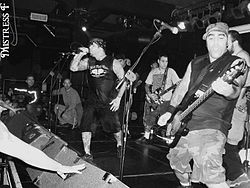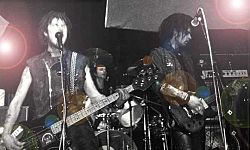Hardcore punk
Hardcore punk (or hardcore) is a style of punk music that usually sounds louder, faster and more angry than earlier punk rock music from the 1970s.[1] Hardcore began in the late 1970s. Some of the important bands of the genre are Bad Brains, Black Flag, D.O.A, Minor Threat and Cro-Mags. Hardcore songs often have more political lyrics (words) than songs from 1970s punk.
No one is quite sure where the term "hardcore punk" came from. The band D.O.A. may have helped to make the term more popular with the title of their album Hardcore '81 in 1981.[2][3][4]
The first hardcore punk song was "Out of Vogue" by the Santa Ana band The Middle Class. This band started to play a loud type of punk with shouted words. At the same time, the Stimulators, a NYC thrash band, performed their song M.A.C.H.I.N.E. which contains all the elements of hardcore punk. The Stimulators played shows with the Bad Brains, who soon created the song Pay to Cum, which was the fastest punk song ever played at the time.
People in hardcore punk bands and people who listened to hardcore punk wore clothes that were of two types. Some people wore clothes and hairstyles that were strange and a bit scary, like Mohawk hairstyles and leather jackets with metal studs. Other people wore regular clothes like black pants and T-shirts.
At hardcore punk concerts, people did a type of dancing called moshing. This type of dance involves people pushing each other and jumping off the stage.
In the early 1980s, hardcore bands from England began to get noticed, such as Discharge, The Exploited, and The Varukers. Discharge played with a sound that included heavy metal guitar styles.
Hardcore led to the creation of the straight edge movement. People who are straight edge do not use alcohol, tobacco, and other drugs. Straight edge led to two new groups, called hardline and youth crew. Hardcore musicians also created independent record labels in the 1980s.
Many bands had a "Do it Yourself" (DIY) attitude. Bands would record their own albums using simple four-track recorders, and the sell the records themselves at shows or through the mail. Hardcore influenced the creation of new styles of music, including alternative rock, grunge, alternative metal, metalcore, thrash metal and post-hardcore.
Politics
Many early hardcore punk bands had songs about liberal politics such as anarchism and socialism. They spoke against political leaders, such as American president Ronald Reagan and British prime minister Margaret Thatcher. While George W. Bush was President of the United States, a number of hardcore bands criticized him. A small number of hardcore musicians have expressed right wing views, including the band Antiseen, whose guitarist Joe Young ran for office as a Libertarian in North Carolina.[5] Former Misfits singer Michale Graves supported George W. Bush.
How it sounds
Hardcore band singers often sing by shouting the words of the song. Hardcore songs often sound like the singer is angry.
Hardcore bands use electric guitars, electric bass guitar, drums, and a singer. The electric guitars in hardcore bands are distorted, noisy, and fuzzy because the guitarists are using electronic boxes called distortion pedals. Some hardcore guitarists have changed the tuning of their guitar strings so they play notes that are lower than those a normal guitar can play.
The drums in hardcore music play loud and fast, often characterized by use of the double-bass pedal, particularly notable in the breakdowns.
Hardcore Punk Media
Audience members moshing to Toxic Holocaust
Negative Approach in T-shirts at a 2013 show
Mike Watt, formerly the bassist for the Minutemen in a 2013 show
Jello Biafra performing with the Dead Kennedys
Facade of the music club CBGB in New York City
Agnostic Front performing
Youth of Today at a 2010 show
References
- ↑ Blush, Stephen (November 9, 2001). American Hardcore: A Tribal History. Feral House. ISBN 0-922915-71-7.
- ↑ "Hardcore Punk music history". Silver Dragon Records. 2003. Archived from the original on 2012-08-29. Retrieved 2006-12-22.
- ↑ "D.O.A. To Rock Toronto International Film Festival". PunkOiUK. Archived from the original on 2015-07-12. Retrieved 2006-12-22.
- ↑ "D.O.A." punknews.org. Retrieved 2006-12-22.
- ↑ Cotton, Quinn (2001-11-17). "Rocked By The Vote | News | Creative Loafing Charlotte". Charlotte.creativeloafing.com. Archived from the original on 2013-04-08. Retrieved 2011-12-04.










